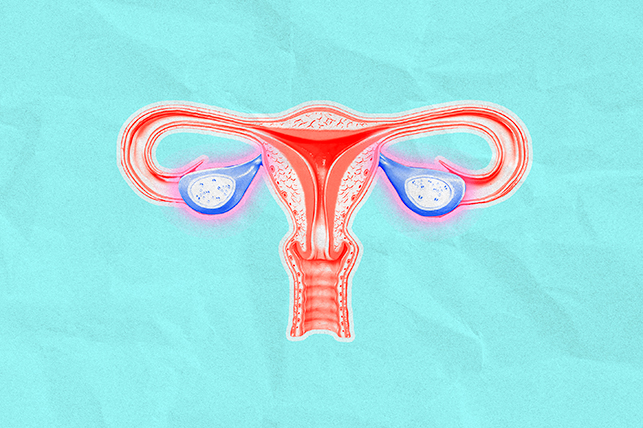What Are the Ovaries and What Do They Do?

The ovaries are two small organs that play a vital role in the female reproductive system. They have two main functions, according to Laura Purdy, M.D., an OB-GYN in Tennessee and the chief medical officer of Wisp, a telehealth company that specializes in women's health: to store and release eggs, and to aid in the production and regulation of the sex hormones estrogen and progesterone.
"The interesting thing about the ovaries is that females are born with all of the eggs they're ever going to have, unlike males, who can produce sperm until they die," Purdy said.
What do the ovaries do?
There is one ovary on each side of the uterus. The ovaries contain thousands of follicles, or small sacs that hold immature eggs. When an individual reaches puberty and becomes fertile, an egg develops and matures inside the ovary once a month, Purdy said.
This development happens somewhere between six and 14 days into the roughly 28-day menstrual cycle, and it's caused by a surge in follicle-stimulating hormone (FSH) from the brain. Around day 14, a surge in luteinizing hormone (LH), also secreted by the brain, causes the ovary to release the egg. This process is called ovulation.
Once released, the egg travels down the fallopian tube. At this time, progesterone levels are elevated in anticipation of pregnancy.
"If you think about the word 'progesterone,' it's the progestational hormone," Purdy explained. "It's designed to support and sustain pregnancy."
If the egg isn't fertilized and, therefore, can't implant itself in the uterine lining, progesterone levels fall. This leads to the shedding of the lining of the uterus, which is known as menstruation. (Implantation happens about 10 to 12 days after ovulation, explaining why a pregnancy test typically isn't positive until the end of the menstrual cycle, Purdy said.)
The progesterone peak occurs in conjunction with an estrogen peak and fall, Purdy explained. This time frame is when people often experience symptoms of PMS, or premenstrual syndrome.
"That's a lot of times when we get the PMS-type symptoms, so lethargy, irritability," she said. "Some people say they feel like they got hit by a truck, they just feel awful, and then menses happens. But it's really the progesterone withdrawal that causes the bleeding."
Ultimately, the intent of the ovaries is to move toward conception, Purdy said.
What do ovaries look like?
The ovaries are shaped like ovals or almonds. Just as each person's body is different, their organs vary in size, too.
"The ovaries are really about the size of a large grape," Purdy said. "Everybody's different, so that's average, but they're not that big."
The average size of an ovary in someone of prime reproductive age, which is also known as premenopausal, is about 1.5 inches long. The ovaries shrink gradually over time and, after menopause, they can become as small as 0.19 inches. Still, they never disappear altogether.
These small organs vary slightly in color, though they usually have a grayish tone and might sometimes appear white.
When ovulation and menstruation don't occur
A number of factors can impact the natural processes that take place inside the ovaries, not all of which are of concern. Contraceptives such as the birth control pill and Plan B are medications that suppress ovulation and prevent it from occurring. Likewise, if you are pregnant or breastfeeding, the body knows it doesn't need to ovulate.
The ovaries and the brain are closely connected, Purdy explained. Certain hormones within the brain signal to the ovaries what they need to do. Any kind of impact on the brain and its hormone levels can have direct effects on the ovaries and, consequently, ovulation and menstruation.
For example, intense stress can cause an increase in adrenal hormones and prevent ovulation and menstruation, Purdy said.
If someone experiences drastic weight loss, has a very low body weight, is anorexic or is an athlete, the potential physiological stress coupled with low levels of body fat can suppress natural estrogen production and prevent someone from ovulating. Someone who has polycystic ovary syndrome (PCOS) and higher levels of androgens—male hormones—might also see their estrogen levels impacted, and they might not ovulate or menstruate regularly.
"So there are lots and lots and lots of things," Purdy said, adding that head and brain injuries, drastic physiological issues, being hospitalized and more can lead to irregularities in ovulation and menstruation.
Symptoms and conditions of the ovaries
Just like any other body part, the ovaries can be the source of a number of illnesses and diseases, ranging from mild to fatal. These include ovarian cancer, which is extremely rare but difficult to diagnose since it usually doesn't present any symptoms, Purdy said. Other ovarian conditions include noncancerous tumors and cysts, the latter of which are quite common and typically not serious.
Ovarian torsion is extremely uncommon but very serious. This condition occurs when the ovary twists on itself and the blood supply gets cut off.
"It's the most dangerous because it's imminently threatening," Purdy said. "The ovary can die within a matter of hours if the blood supply is not restored."
In general, symptoms of problems within the ovaries include pain or pressure in the pelvis, intense bloating, nausea or diarrhea, irregular vaginal bleeding, and irregular or abnormally painful periods. If you experience any of these symptoms, particularly during ovulation or menstruation, you should see your healthcare provider to determine whether or not your ovaries are healthy.
If you don't have a physician you see regularly, taking that first step can feel daunting. Video visits have become a viable option for most people, and more physicians, including OB-GYNs, have added them as a service. Giddy telehealth makes it easy to get connected to a qualified healthcare professional who can help with a variety of conditions.


















